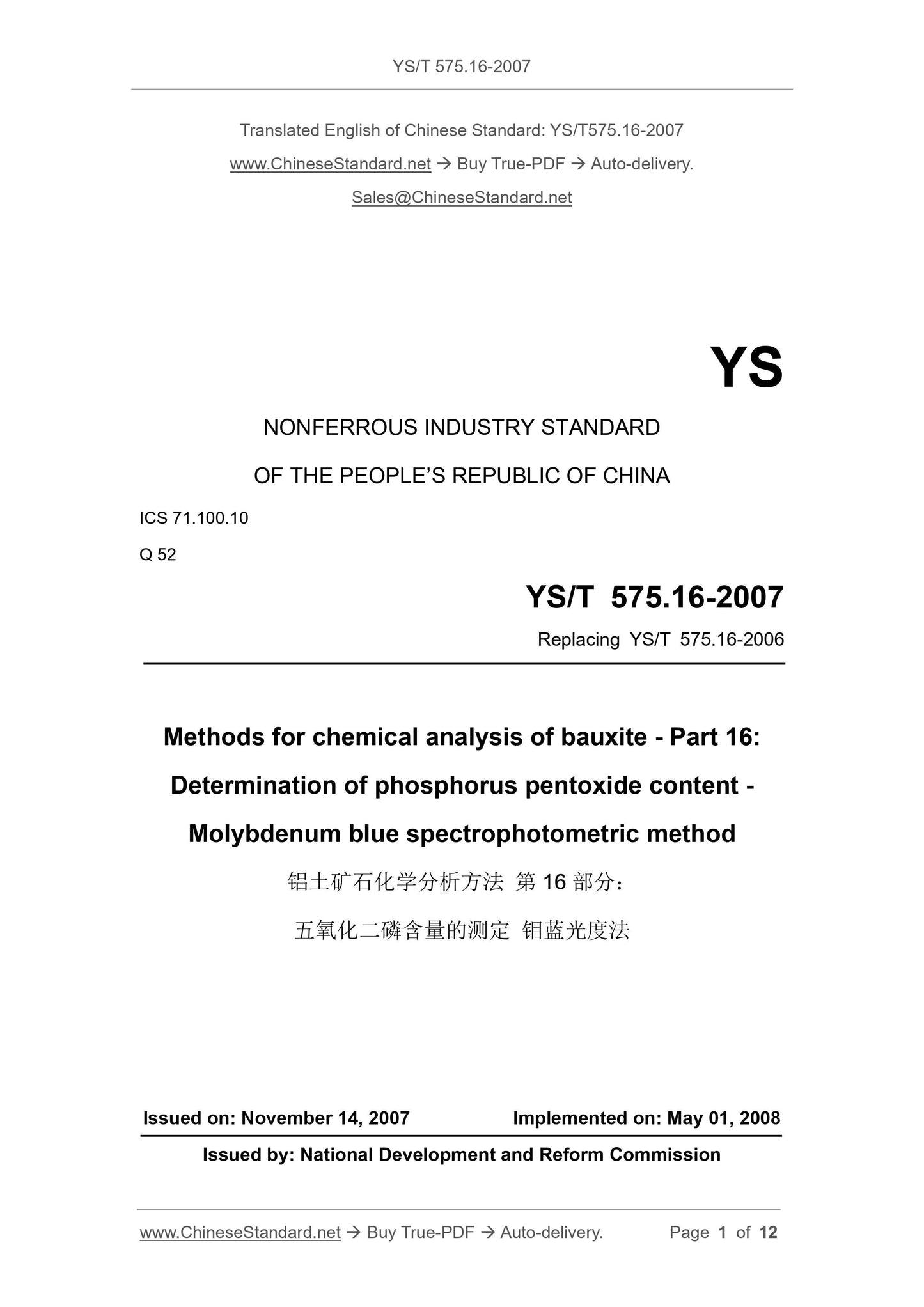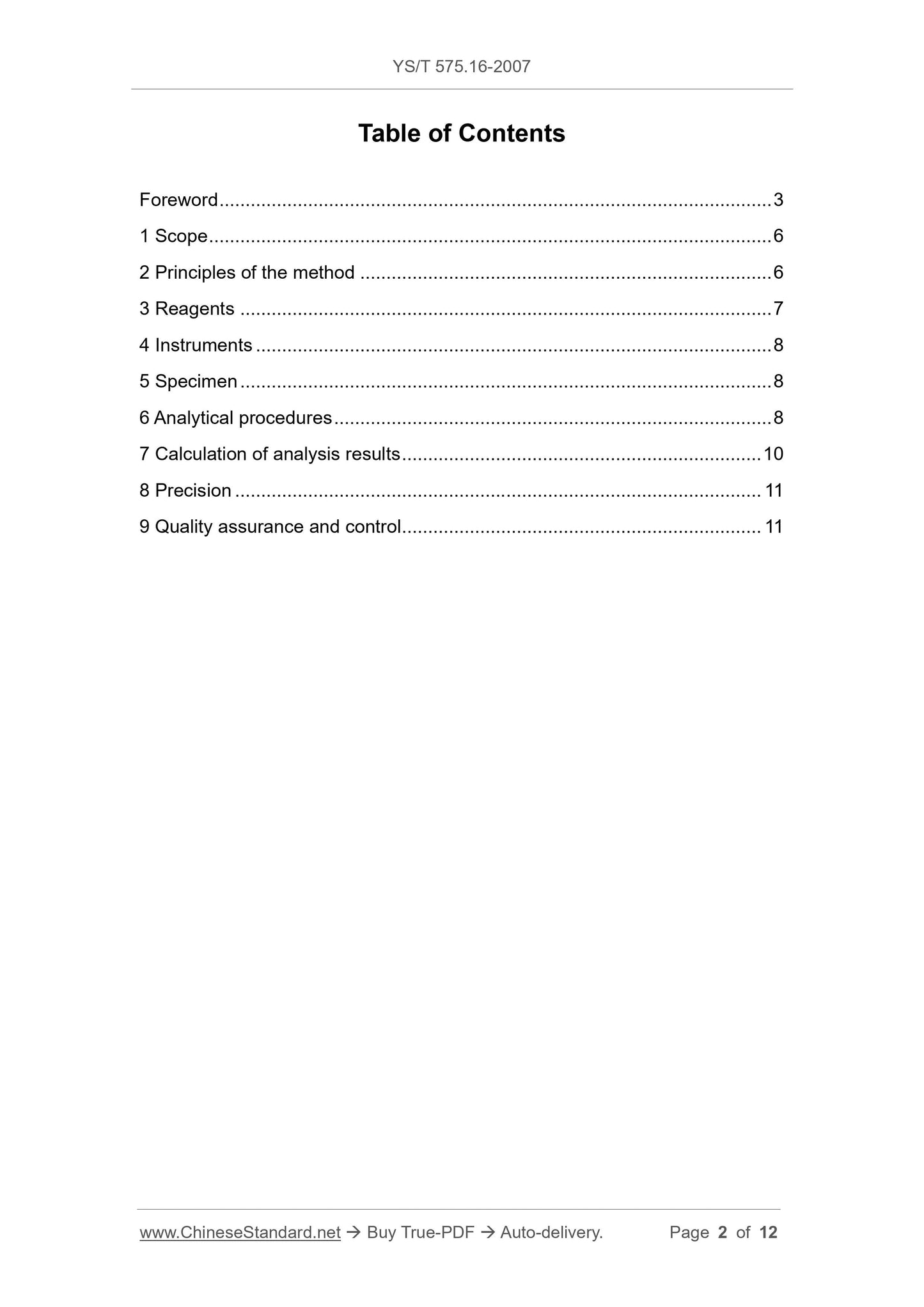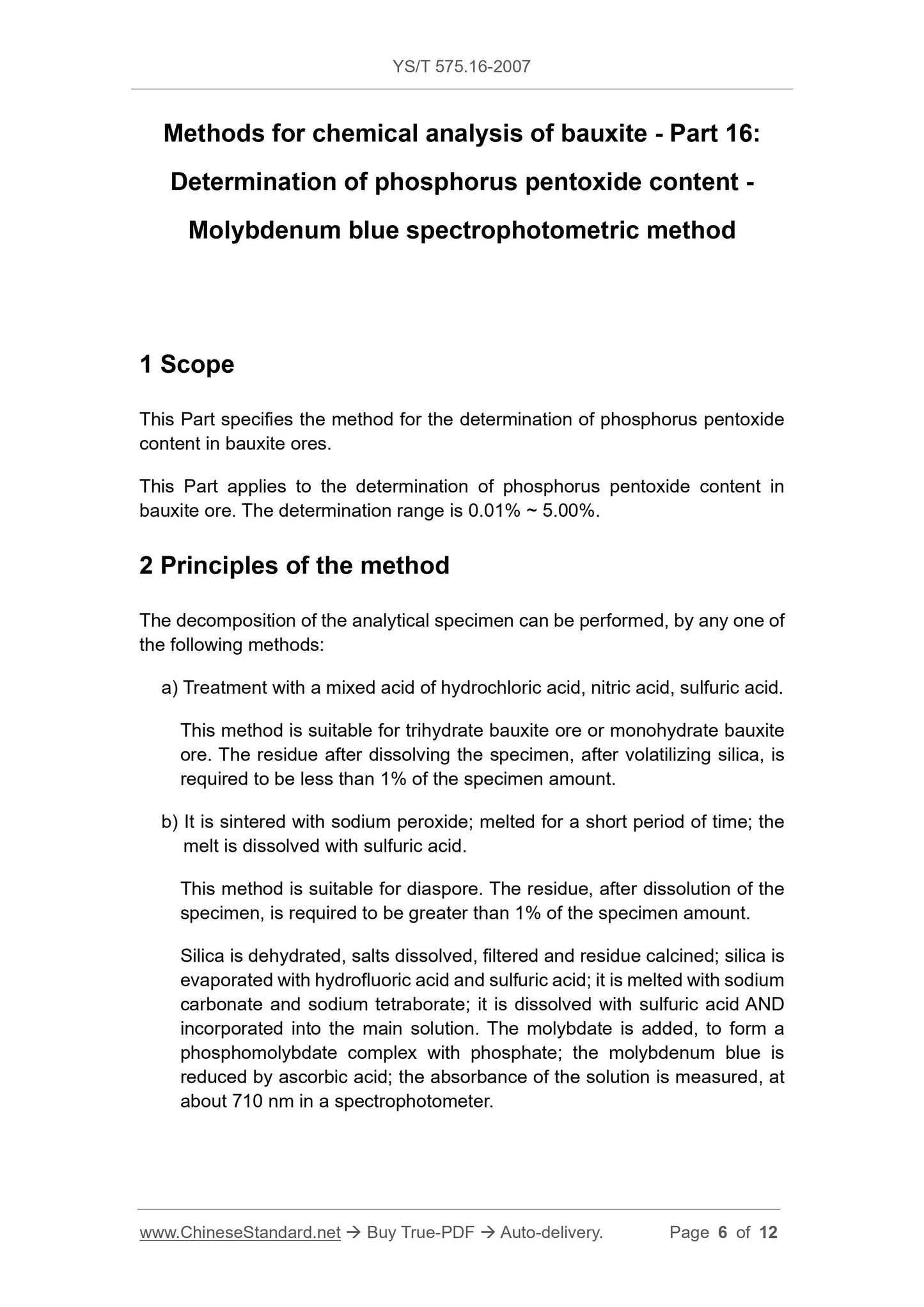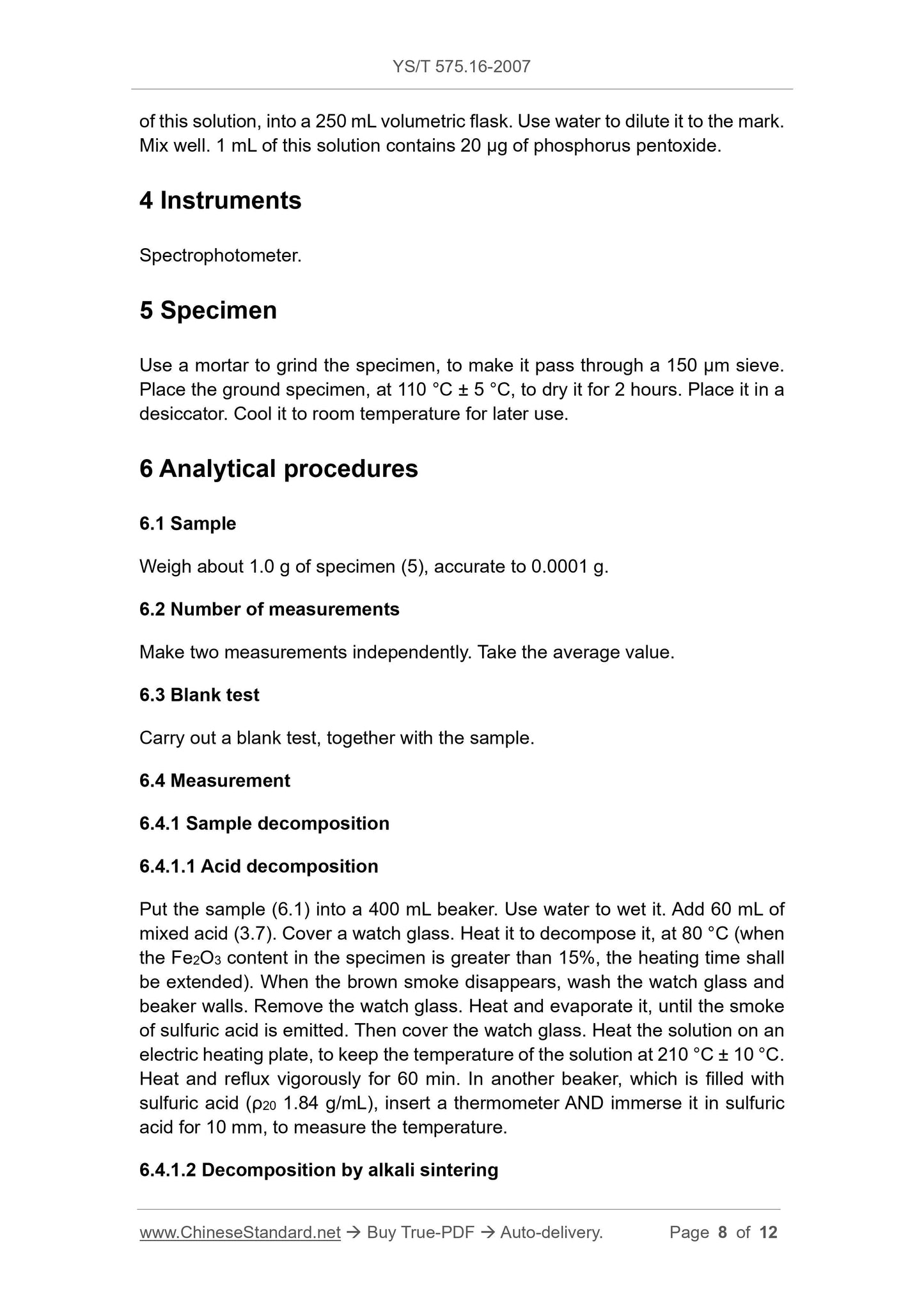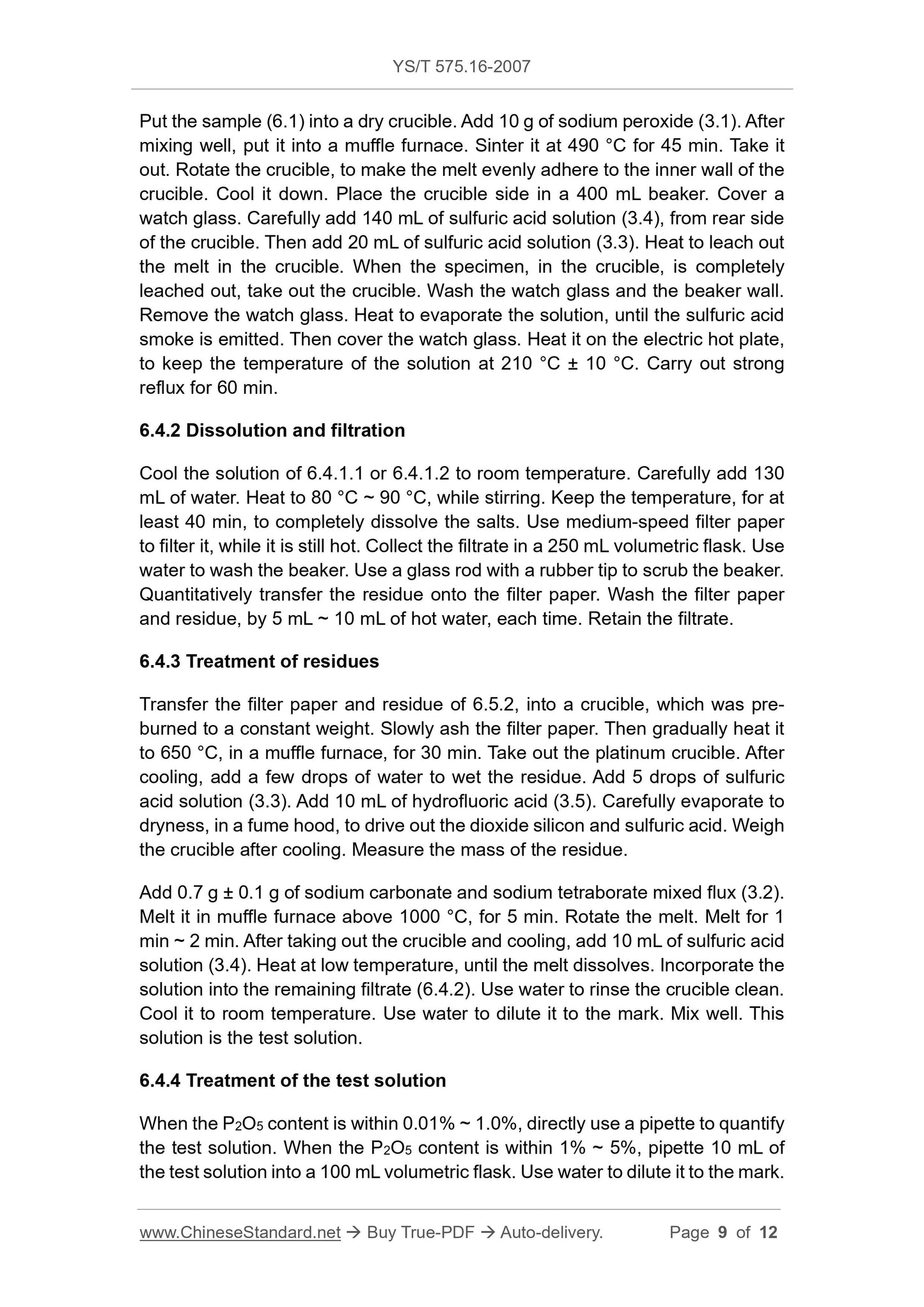1
/
av
5
PayPal, credit cards. Download editable-PDF and invoice in 1 second!
YS/T 575.16-2007 English PDF (YST575.16-2007)
YS/T 575.16-2007 English PDF (YST575.16-2007)
Ordinarie pris
$170.00 USD
Ordinarie pris
Försäljningspris
$170.00 USD
Enhetspris
/
per
Frakt beräknas i kassan.
Det gick inte att ladda hämtningstillgänglighet
Delivery: 3 seconds. Download true-PDF + Invoice.
Get QUOTATION in 1-minute: Click YS/T 575.16-2007
Historical versions: YS/T 575.16-2007
Preview True-PDF (Reload/Scroll if blank)
YS/T 575.16-2007: Methods for chemical analysis of bauxite. Part 16: Determination of phosphorus pentoxide content. Molybdenum blue spectrophotometric method
YS/T 575.16-2007
YS
NONFERROUS INDUSTRY STANDARD
OF THE PEOPLE’S REPUBLIC OF CHINA
ICS 71.100.10
Q 52
Replacing YS/T 575.16-2006
Methods for chemical analysis of bauxite - Part 16:
Determination of phosphorus pentoxide content -
Molybdenum blue spectrophotometric method
ISSUED ON: NOVEMBER 14, 2007
IMPLEMENTED ON: MAY 01, 2008
Issued by: National Development and Reform Commission
Table of Contents
Foreword ... 3
1 Scope ... 6
2 Principles of the method ... 6
3 Reagents ... 7
4 Instruments ... 8
5 Specimen ... 8
6 Analytical procedures ... 8
7 Calculation of analysis results ... 10
8 Precision ... 11
9 Quality assurance and control ... 11
Methods for chemical analysis of bauxite - Part 16:
Determination of phosphorus pentoxide content -
Molybdenum blue spectrophotometric method
1 Scope
This Part specifies the method for the determination of phosphorus pentoxide
content in bauxite ores.
This Part applies to the determination of phosphorus pentoxide content in
bauxite ore. The determination range is 0.01% ~ 5.00%.
2 Principles of the method
The decomposition of the analytical specimen can be performed, by any one of
the following methods:
a) Treatment with a mixed acid of hydrochloric acid, nitric acid, sulfuric acid.
This method is suitable for trihydrate bauxite ore or monohydrate bauxite
ore. The residue after dissolving the specimen, after volatilizing silica, is
required to be less than 1% of the specimen amount.
b) It is sintered with sodium peroxide; melted for a short period of time; the
melt is dissolved with sulfuric acid.
This method is suitable for diaspore. The residue, after dissolution of the
specimen, is required to be greater than 1% of the specimen amount.
Silica is dehydrated, salts dissolved, filtered and residue calcined; silica is
evaporated with hydrofluoric acid and sulfuric acid; it is melted with sodium
carbonate and sodium tetraborate; it is dissolved with sulfuric acid AND
incorporated into the main solution. The molybdate is added, to form a
phosphomolybdate complex with phosphate; the molybdenum blue is
reduced by ascorbic acid; the absorbance of the solution is measured, at
about 710 nm in a spectrophotometer.
of this solution, into a 250 mL volumetric flask. Use water to dilute it to the mark.
Mix well. 1 mL of this solution contains 20 μg of phosphorus pentoxide.
4 Instruments
Spectrophotometer.
5 Specimen
Use a mortar to grind the specimen, to make it pass through a 150 µm sieve.
Place the ground specimen, at 110 °C ± 5 °C, to dry it for 2 hours. Place it in a
desiccator. Cool it to room temperature for later use.
6 Analytical procedures
6.1 Sample
Weigh about 1.0 g of specimen (5), accurate to 0.0001 g.
6.2 Number of measurements
Make two measurements independently. Take the average value.
6.3 Blank test
Carry out a blank test, together with the sample.
6.4 Measurement
6.4.1 Sample decomposition
6.4.1.1 Acid decomposition
Put the sample (6.1) into a 400 mL beaker. Use water to wet it. Add 60 mL of
mixed acid (3.7). Cover a watch glass. Heat it to decompose it, at 80 °C (when
the Fe2O3 content in the specimen is greater than 15%, the heating time shall
be extended). When the brown smoke disappears, wash the watch glass and
beaker walls. Remove the watch glass. Heat and evaporate it, until the smoke
of sulfuric acid is emitted. Then cover the watch glass. Heat the solution on an
electric heating plate, to keep the temperature of the solution at 210 °C ± 10 °C.
Heat and reflux vigorously for 60 min. In another beaker, which is filled with
sulfuric acid (ρ20 1.84 g/mL), insert a thermometer AND immerse it in sulfuric
acid for 10 mm, to measure the temperature.
6.4.1.2 Decomposition by alkali sintering
Put the sample (6.1) into a dry crucible. Add 10 g of sodium peroxide (3.1). After
mixing well, put it into a muffle furnace. Sinter it at 490 °C for 45 min. Take it
out. Rotate the crucible, to make the melt evenly adhere to the inner wall of the
crucible. Cool it down. Place the crucible side in a 400 mL beaker. Cover a
watch glass. Carefully add 140 mL of sulfuric acid solution (3.4), from rear side
of the crucible. Then add 20 mL of sulfuric acid solution (3.3). Heat to leach out
the melt in the crucible. When the specimen, in the crucible, is completely
leached out, take out the crucible. Wash the watch glass and the beaker wall.
Remove the watch glass. Heat to evaporate the solution, until the sulfuric acid
smoke is emitted. Then cover the watch glass. Heat it on the electric hot plate,
to keep the temperature of the solution at 210 °C ± 10 °C. Carry out strong
reflux for 60 min.
6.4.2 Dissolution and filtration
Cool the solution of 6.4.1.1 or 6.4.1.2 to room temperature. Carefully add 130
mL of water. Heat to 80 °C ~ 90 °C, while stirring. Keep the temperature, for at
least 40 min, to completely dissolve the salts. Use medium-speed filter paper
to filter it, while it is still hot. Collect the filtrate in a 250 mL volumetric flask. Use
water to wash the beaker. Use a glass rod with a rubber tip to scrub the beaker.
Quantitatively transfer the residue onto the filter paper. Wash the filter paper
and residue, by 5 mL ~ 10 mL of hot water, each time. Retain the filtrate.
6.4.3 Treatment of residues
Transfer the filter paper and residue of 6.5.2, into a crucible, which was pre-
burned to a constant weight. Slowly ash the filter paper. Then gradually heat it
to 650 °C, in a muffle furnace, for 30 min. Take out the platinum crucible. After
cooling, add a few drops of water to wet the residue. Add 5 drops of sulfuric
acid solution (3.3). Add 10 mL of hydrofluoric acid (3.5). Carefully evaporate to
dryness, in a fume hood, to drive out the dioxide silicon and sulfuric acid. Weigh
the crucible after cooling. Measure the mass of the residue.
Add 0.7 g ± 0.1 g of sodium carbonate and sodium tetraborate mixed flux (3.2).
Melt it in muffle furnace above 1000 °C, for 5 min. Rotate the melt. Melt for 1
min ~ 2 min. After taking out the crucible and cooling, add 10 mL of sulfuric acid
solution (3.4). Heat at low temperature, until the melt dissolves. Incorporate the
solution into the remaining filtrate (6.4.2). Use water to rinse the crucible clean.
Cool it to room temperature. Use water to dilute it to the mark. Mix well. This
solution is the test solution.
6.4.4 Treatment of the test solution
When the P2O5 content is within 0.01% ~ 1.0%, directly use a pipette to quantify
the test solution. When the P2O5 content is within 1% ~ 5%, pipette 10 mL of
the test solution into a 100 mL volumetric flask. Use water to dilute it to the mark.
Get QUOTATION in 1-minute: Click YS/T 575.16-2007
Historical versions: YS/T 575.16-2007
Preview True-PDF (Reload/Scroll if blank)
YS/T 575.16-2007: Methods for chemical analysis of bauxite. Part 16: Determination of phosphorus pentoxide content. Molybdenum blue spectrophotometric method
YS/T 575.16-2007
YS
NONFERROUS INDUSTRY STANDARD
OF THE PEOPLE’S REPUBLIC OF CHINA
ICS 71.100.10
Q 52
Replacing YS/T 575.16-2006
Methods for chemical analysis of bauxite - Part 16:
Determination of phosphorus pentoxide content -
Molybdenum blue spectrophotometric method
ISSUED ON: NOVEMBER 14, 2007
IMPLEMENTED ON: MAY 01, 2008
Issued by: National Development and Reform Commission
Table of Contents
Foreword ... 3
1 Scope ... 6
2 Principles of the method ... 6
3 Reagents ... 7
4 Instruments ... 8
5 Specimen ... 8
6 Analytical procedures ... 8
7 Calculation of analysis results ... 10
8 Precision ... 11
9 Quality assurance and control ... 11
Methods for chemical analysis of bauxite - Part 16:
Determination of phosphorus pentoxide content -
Molybdenum blue spectrophotometric method
1 Scope
This Part specifies the method for the determination of phosphorus pentoxide
content in bauxite ores.
This Part applies to the determination of phosphorus pentoxide content in
bauxite ore. The determination range is 0.01% ~ 5.00%.
2 Principles of the method
The decomposition of the analytical specimen can be performed, by any one of
the following methods:
a) Treatment with a mixed acid of hydrochloric acid, nitric acid, sulfuric acid.
This method is suitable for trihydrate bauxite ore or monohydrate bauxite
ore. The residue after dissolving the specimen, after volatilizing silica, is
required to be less than 1% of the specimen amount.
b) It is sintered with sodium peroxide; melted for a short period of time; the
melt is dissolved with sulfuric acid.
This method is suitable for diaspore. The residue, after dissolution of the
specimen, is required to be greater than 1% of the specimen amount.
Silica is dehydrated, salts dissolved, filtered and residue calcined; silica is
evaporated with hydrofluoric acid and sulfuric acid; it is melted with sodium
carbonate and sodium tetraborate; it is dissolved with sulfuric acid AND
incorporated into the main solution. The molybdate is added, to form a
phosphomolybdate complex with phosphate; the molybdenum blue is
reduced by ascorbic acid; the absorbance of the solution is measured, at
about 710 nm in a spectrophotometer.
of this solution, into a 250 mL volumetric flask. Use water to dilute it to the mark.
Mix well. 1 mL of this solution contains 20 μg of phosphorus pentoxide.
4 Instruments
Spectrophotometer.
5 Specimen
Use a mortar to grind the specimen, to make it pass through a 150 µm sieve.
Place the ground specimen, at 110 °C ± 5 °C, to dry it for 2 hours. Place it in a
desiccator. Cool it to room temperature for later use.
6 Analytical procedures
6.1 Sample
Weigh about 1.0 g of specimen (5), accurate to 0.0001 g.
6.2 Number of measurements
Make two measurements independently. Take the average value.
6.3 Blank test
Carry out a blank test, together with the sample.
6.4 Measurement
6.4.1 Sample decomposition
6.4.1.1 Acid decomposition
Put the sample (6.1) into a 400 mL beaker. Use water to wet it. Add 60 mL of
mixed acid (3.7). Cover a watch glass. Heat it to decompose it, at 80 °C (when
the Fe2O3 content in the specimen is greater than 15%, the heating time shall
be extended). When the brown smoke disappears, wash the watch glass and
beaker walls. Remove the watch glass. Heat and evaporate it, until the smoke
of sulfuric acid is emitted. Then cover the watch glass. Heat the solution on an
electric heating plate, to keep the temperature of the solution at 210 °C ± 10 °C.
Heat and reflux vigorously for 60 min. In another beaker, which is filled with
sulfuric acid (ρ20 1.84 g/mL), insert a thermometer AND immerse it in sulfuric
acid for 10 mm, to measure the temperature.
6.4.1.2 Decomposition by alkali sintering
Put the sample (6.1) into a dry crucible. Add 10 g of sodium peroxide (3.1). After
mixing well, put it into a muffle furnace. Sinter it at 490 °C for 45 min. Take it
out. Rotate the crucible, to make the melt evenly adhere to the inner wall of the
crucible. Cool it down. Place the crucible side in a 400 mL beaker. Cover a
watch glass. Carefully add 140 mL of sulfuric acid solution (3.4), from rear side
of the crucible. Then add 20 mL of sulfuric acid solution (3.3). Heat to leach out
the melt in the crucible. When the specimen, in the crucible, is completely
leached out, take out the crucible. Wash the watch glass and the beaker wall.
Remove the watch glass. Heat to evaporate the solution, until the sulfuric acid
smoke is emitted. Then cover the watch glass. Heat it on the electric hot plate,
to keep the temperature of the solution at 210 °C ± 10 °C. Carry out strong
reflux for 60 min.
6.4.2 Dissolution and filtration
Cool the solution of 6.4.1.1 or 6.4.1.2 to room temperature. Carefully add 130
mL of water. Heat to 80 °C ~ 90 °C, while stirring. Keep the temperature, for at
least 40 min, to completely dissolve the salts. Use medium-speed filter paper
to filter it, while it is still hot. Collect the filtrate in a 250 mL volumetric flask. Use
water to wash the beaker. Use a glass rod with a rubber tip to scrub the beaker.
Quantitatively transfer the residue onto the filter paper. Wash the filter paper
and residue, by 5 mL ~ 10 mL of hot water, each time. Retain the filtrate.
6.4.3 Treatment of residues
Transfer the filter paper and residue of 6.5.2, into a crucible, which was pre-
burned to a constant weight. Slowly ash the filter paper. Then gradually heat it
to 650 °C, in a muffle furnace, for 30 min. Take out the platinum crucible. After
cooling, add a few drops of water to wet the residue. Add 5 drops of sulfuric
acid solution (3.3). Add 10 mL of hydrofluoric acid (3.5). Carefully evaporate to
dryness, in a fume hood, to drive out the dioxide silicon and sulfuric acid. Weigh
the crucible after cooling. Measure the mass of the residue.
Add 0.7 g ± 0.1 g of sodium carbonate and sodium tetraborate mixed flux (3.2).
Melt it in muffle furnace above 1000 °C, for 5 min. Rotate the melt. Melt for 1
min ~ 2 min. After taking out the crucible and cooling, add 10 mL of sulfuric acid
solution (3.4). Heat at low temperature, until the melt dissolves. Incorporate the
solution into the remaining filtrate (6.4.2). Use water to rinse the crucible clean.
Cool it to room temperature. Use water to dilute it to the mark. Mix well. This
solution is the test solution.
6.4.4 Treatment of the test solution
When the P2O5 content is within 0.01% ~ 1.0%, directly use a pipette to quantify
the test solution. When the P2O5 content is within 1% ~ 5%, pipette 10 mL of
the test solution into a 100 mL volumetric flask. Use water to dilute it to the mark.
Share
